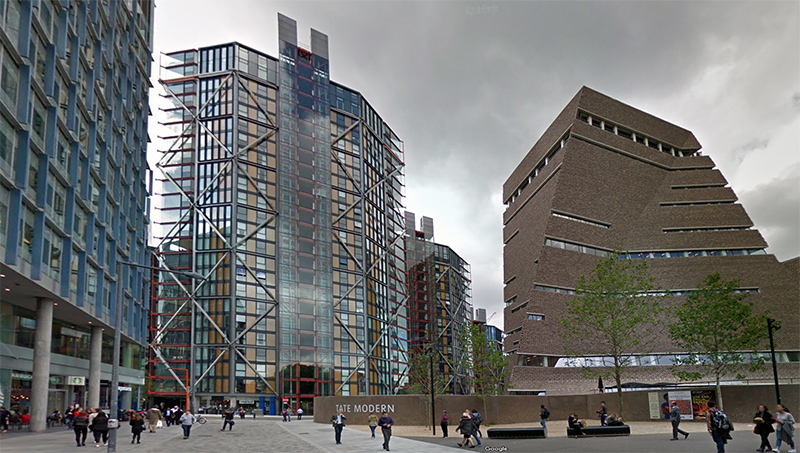
The Tate Gallery viewing platform judgment: a new judicial approach
The viewing platform at the Tate Gallery constitutes a nuisance to the occupants of nearby luxury flats, according to the Supreme Court. The case has important ramifications throughout the area of the law of nuisance which is concerned with pollution caused by ‘intangible’ interferences (such as claims about dust, odours and noise).
The Supreme Court’s decision must have come as a surprise to both the trial judge and the Court of Appeal.
As to the trial judge, he decided that although interference with privacy from a viewing platform can constitute a nuisance, the claim was not made out because the affected properties were unduly sensitive: the living areas had been built from top to bottom with a glass front. The claimants had aggravated their predicament by converting the internal balcony areas of their flats into extra living accommodation. Moreover, they could easily have taken steps themselves to limit their loss of privacy by way of the use of blinds or curtains. By the standards to be applied to this location in south London, they had brought their problems on themselves.
As to the judges in the Court of Appeal, they had decided that the flat-dwellers’ complaints were really about ‘overlooking’ which were not within the scope of the tort of nuisance at all. In truth, these were claims about loss of privacy.
Lord Leggatt JSC was not impressed by either approach. He said that this was a “straightforward” case, the categories of nuisance not being closed. The extent of the intrusion, including mobile phone footage of the flats taken by tens of thousands of visitors every year, was more than a loss of privacy. It was an actionable nuisance. Lord Leggatt went on to decide that it was contrary to established principle to say that the flat dwellers could have brought matters on themselves.
The judge’s reasoning carries important consequences for other claims of nuisance in this area, his judgment being adopted by two other members of the Court.
Leggatt JSC’s primary reasoning is encapsulated by his emphasis on “the priority accorded to the general and ordinary use of land”, as he saw it, at common law. This means that if a defendant is only doing what is necessary for the “ordinary” use of land, then a claimant would not have a claim. Moreover, if the defendant makes use of his property not for “ordinary” purposes, but for an uncommon or unusual purpose, then that defendant cannot justify the resultant nuisance by saying that the claimant has brought matters on himself by some “abnormally sensitive” characteristic.
On the facts themselves, Leggatt JSC remarked that the gallery’s viewing platform was not an “ordinary” use of land. It was uncommon and exceptional. The claimants, on the other hand, were using use their land for “ordinary” purposes, since they were simply living in their flats. They therefore had a right to enjoy their flats without being accused of undue sensitivity, and it was not for them to have to take steps to avert or mitigate the nuisance brought about by the Gallery in the exceptional use of its neighbouring property.
The judge went on to make it clear that a defendant cannot argue that a claimant must accept the effects of an uncommon use of its land, in particular by the construction of a novel or distinctive building. He firmly rejected any justification on the basis that the viewing platform, or the gallery, had been constructed for the public good (pro bono publico).
This judgment is extremely important not only by reason of the importance which Leggatt JSC attaches to the “ordinary” use of land, although, by itself, this will make the assessment of novel circumstances much more difficult than it has been to date (especially where a claimant can persuade a court that ultimately its use of land is for the straightforward purposes of housing or office space). More than this, the case is important since Leggatt JSC decided that the approach of a judge to a claim in nuisance should be more than the type of assessment which is often characterised as a “jury question”.
The minority judgment written by Sales JSC is well worth reading, the two justices committing themselves to the view that the majority decision did “not affirm established principle, but instead would constitute a major change in the law” (para.245).
Sales JSC ran through the principles relevant to a claim in nuisance of this type, rather as Leggatt JSC had done, but with a much more traditional deference to the decision of the trial judge and to the balancing of those applicable principles as “overlapping themes” rather than as distinct pillars, each carrying different weights. The minority’s judgment reflects the approach of Laws LJ in Arscott v. The Coal Authority [2004] EWCA (Civ) 892, [2005] Env. L.R. 6, a judgment which, regrettably, was not cited in the Supreme Court.
The decision of the majority calls for a new approach. There will now be an inevitable emphasis on the meaning of “ordinary” use of land (to the advantage of claimants) and a less forgiving attitude to those judgments which cannot be clearly broken down into distinct topics. This is an approach is one which judges are likely to find challenging.
Fearn v. Board of Trustees of the Tate Gallery [2023] UKSC 4 | [2023] 2 W.L.R. 339